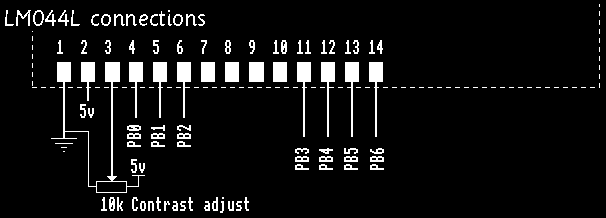Many applciations arise when you might want to use either a cut down BBC (just the processor, some RAM and an IO port) in, for example, a burgular alarm system or when it is not practical to use a 14" monitor (eg a shop cash register).
Use of a liquid display crystal display would alleviate the need for complex colour video generating circuitry.
The system described in this article uses the Hitachi LM044L 20 column by 4 line LCD module available from electronics distributors.
Parts

The above circuit diagram shows electrically how to assemble the unit. It requires the following parts:
| 1 | x | LM044L (Farnell Part Number: 325429) |
| 1 | x | 10k variable resistor |
| 1 | x | 5v power supply (eg 4 x AA batteries) |
| 1 | x | 20 way IDC user port connector |
| 1 | x | Length of 20 way ribbon cable |
Benefits
- No bulky/unreliable cathode ray tubes
- Far more compact
- Runs off 5v supply
- Could be used with cut down BBCs in embedded applications
- Screen contrast is adjustable in poor viewing situations
How To Build
- Simply split the 20 way ribbon cable and connect as suggested in the diagram,
- add the 10k potential divider to control the contrast across the marked pins on the diagram. Be sure to get the gold card edge connectors the right way round,
- add the power supply, and
- crimp the IDC plug on the other end of the ribbon cable and connect to the BBC micro's user port.
Hints
- Since LCDs are so efficient, the 5v supply can be derived from the two 5v pins on the BBC's user port plug.
- Run the software with *LCD. It loads below the Mode 7 screen memory.
- The software implements all of the VDU commands that are supported by OS1.20 and that are related to text operations. For example, you can't do any graphics plotting!
- The cursor is controlled by the use of VDU23 allowing it to be turned off in applications that require this.
- The whole VDU queue is then passed on the operating system so output will appear on both the LCD and the normal BBC's screen.
Happy soldering from Robert Sprowson!